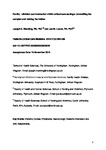Family-Clinician Communication Within Critical Care Settings: Unraveling the Complex and Valuing the Hidden
| dc.contributor.author | Manning, JC | |
| dc.contributor.author | Latour, Jos M | |
| dc.date.accessioned | 2018-08-13T13:53:04Z | |
| dc.date.available | 2018-08-13T13:53:04Z | |
| dc.date.issued | 2016-03 | |
| dc.identifier.issn | 1529-7535 | |
| dc.identifier.issn | 1947-3893 | |
| dc.identifier.uri | http://hdl.handle.net/10026.1/12080 | |
| dc.description.abstract |
Internationally, advances in medicine and technology have led to a growing repertoire of interventions that can save or prolong lives of critically ill infants and children. Key developments include: resuscitation practices; continuous monitoring methods; ventilation devices and strategies; and artificial organs [1]. Interventions have also been developed to support parents and enhance communication between families and pediatric critical care professionals. In neonatology the Newborn Individualized Developmental Care and Assessment Program (NIDCAP) has proven to be beneficial in supporting both infants and parents [2, 3]. A range of communication strategies have been developed and tested, such as audio-recording parent—physician consultations, and the use of infant progress charts, videos or web-links [4]. Despite increased treatment efficacy, moral and ethical challenges remain [5] which add significant complexity when navigating, negotiating, and communicating treatment pathways with parents and families. | |
| dc.format.extent | 264-265 | |
| dc.format.medium | ||
| dc.language | en | |
| dc.language.iso | en | |
| dc.publisher | Ovid Technologies (Wolters Kluwer Health) | |
| dc.subject | clinicians | |
| dc.subject | neonatology | |
| dc.subject | parents | |
| dc.subject | pediatric intensive care unit | |
| dc.subject | relationship | |
| dc.title | Family-Clinician Communication Within Critical Care Settings: Unraveling the Complex and Valuing the Hidden | |
| dc.type | journal-article | |
| dc.type | Editorial | |
| dc.type | Comment | |
| plymouth.author-url | http://gateway.webofknowledge.com/gateway/Gateway.cgi?GWVersion=2&SrcApp=PARTNER_APP&SrcAuth=LinksAMR&KeyUT=WOS:000371747500015&DestLinkType=FullRecord&DestApp=ALL_WOS&UsrCustomerID=11bb513d99f797142bcfeffcc58ea008 | |
| plymouth.issue | 3 | |
| plymouth.volume | 17 | |
| plymouth.publication-status | Published | |
| plymouth.journal | PEDIATRIC CRITICAL CARE MEDICINE | |
| dc.identifier.doi | 10.1097/PCC.0000000000000646 | |
| plymouth.organisational-group | /Plymouth | |
| plymouth.organisational-group | /Plymouth/Faculty of Health | |
| plymouth.organisational-group | /Plymouth/REF 2021 Researchers by UoA | |
| plymouth.organisational-group | /Plymouth/REF 2021 Researchers by UoA/UoA03 Allied Health Professions, Dentistry, Nursing and Pharmacy | |
| plymouth.organisational-group | /Plymouth/Research Groups | |
| plymouth.organisational-group | /Plymouth/Research Groups/Institute of Health and Community | |
| plymouth.organisational-group | /Plymouth/Users by role | |
| plymouth.organisational-group | /Plymouth/Users by role/Academics | |
| dc.publisher.place | United States | |
| dcterms.dateAccepted | 2015-11-18 | |
| dc.rights.embargodate | 2023-10-11 | |
| dc.identifier.eissn | 1947-3893 | |
| dc.rights.embargoperiod | Not known | |
| rioxxterms.versionofrecord | 10.1097/PCC.0000000000000646 | |
| rioxxterms.licenseref.uri | http://www.rioxx.net/licenses/all-rights-reserved | |
| rioxxterms.licenseref.startdate | 2016-03 | |
| rioxxterms.type | Journal Article/Review |


